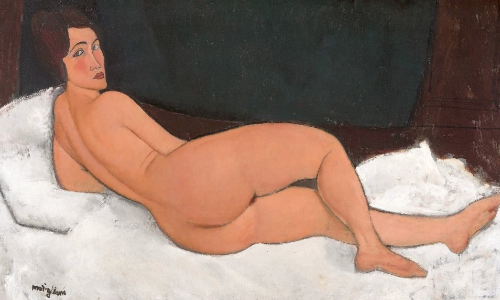Review: Modigliani

Amedeo Modigliani is a man whose life was more interesting than his art. It was 1906 when he packed up his easel and moved from Italy to Paris, then the bohemian centre of the universe, diving face-first into its torrid world of sex ‘n’ drugs ‘n’ accordion music.
Here he mingled with some of the greatest artists who ever lived, painting voraciously as he slid inexorably into a life of drug and alcohol addiction, his constitution becoming ever-more sickly, his distaste for his own bourgeois upbringing growing with every passing day. Before his death from tuberculosis aged just 35, he hurled himself into abject poverty, attempting to destroy much of his early work, which he had grown to despise.
This rich seam of anger and self-hatred runs throughout his oeuvre – indeed, it’s the only thing that elevates many of his paintings from simple flattery of the artists who so clearly informed them; the lively post-expressionism of Cezanne, the flattened, cubist shapes of Picasso.
Modigliani is famous for painting elongated faces and almond-shaped eyes and swan-like necks. But it’s the ostentatious, often cartoonish darkness that really comes through in this exhibition – the dead, mannequin eyes and black, hollow eyes and blind, filmy eyes. He sees death everywhere, projecting it onto those around him, perhaps sensing that his own wasn’t far away. His portrait of fellow artist Leon Indenbaum – actually a pretty handsome bloke – is utterly horrifying, the stuff of nightmares, like a Victorian post-mortem portrait.
In another, Nude Study, a pale woman kneels like a banshee with the silent, passive expression of a slasher movie antagonist (in this and other paintings he reused the canvas, and a ghostly, inverted second face peers through his dirty brush-strokes). I wonder whether this may in fact be the artist’s most enduring legacy, with the language of his paintings trotted out almost verbatim in a thousand horror movies; in the new version of Stephen King’s IT, the clown literally takes the form of a fictional Modigliani painting.
Modigliani was also a diarist of bohemian Paris, hanging out with artists and musicians and poets. But he wasn’t exactly the only one documenting the period, and many of his works now feel so cosily familiar that they’ve taken on a kitsch quality, the themes and scenes played out so many times in so many mediums over the last century.
The show’s crescendo comes courtesy of a room full of nudes, with rosy pink flesh quivering on every wall, all coy expressions and round bottoms and flashes of pubic hair. Considered risqué in 1917, these pieces now have an almost classical sensibility, a million miles from Picasso’s nudes from the same period which are still startling and thrusting and brilliant.
After the nudes, the exhibition runs out of steam (apart from an excellent VR exhibit in which you can experience Modigliani’s squalid studio at different stages of his life). There are just too many tonally and compositionally similar portraits of people with funny-shaped heads, few of them individually good enough to warrant much attention.
First published in City A.M.

